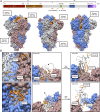Design and proof of concept for targeted phage-based COVID-19 vaccination strategies with a streamlined cold-free supply chain
- PMID: 34234013
- PMCID: PMC8325333
- DOI: 10.1073/pnas.2105739118
Design and proof of concept for targeted phage-based COVID-19 vaccination strategies with a streamlined cold-free supply chain
Abstract
Development of effective vaccines against coronavirus disease 2019 (COVID-19) is a global imperative. Rapid immunization of the entire human population against a widespread, continually evolving, and highly pathogenic virus is an unprecedented challenge, and different vaccine approaches are being pursued. Engineered filamentous bacteriophage (phage) particles have unique potential in vaccine development due to their inherent immunogenicity, genetic plasticity, stability, cost-effectiveness for large-scale production, and proven safety profile in humans. Herein we report the development and initial evaluation of two targeted phage-based vaccination approaches against SARS-CoV-2: dual ligand peptide-targeted phage and adeno-associated virus/phage (AAVP) particles. For peptide-targeted phage, we performed structure-guided antigen design to select six solvent-exposed epitopes of the SARS-CoV-2 spike (S) protein. One of these epitopes displayed on the major capsid protein pVIII of phage induced a specific and sustained humoral response when injected in mice. These phage were further engineered to simultaneously display the peptide CAKSMGDIVC on the minor capsid protein pIII to enable their transport from the lung epithelium into the systemic circulation. Aerosolization of these "dual-display" phage into the lungs of mice generated a systemic and specific antibody response. In the second approach, targeted AAVP particles were engineered to deliver the entire S protein gene under the control of a constitutive CMV promoter. This induced tissue-specific transgene expression, stimulating a systemic S protein-specific antibody response in mice. With these proof-of-concept preclinical experiments, we show that both targeted phage- and AAVP-based particles serve as robust yet versatile platforms that can promptly yield COVID-19 vaccine prototypes for translational development.
Keywords: AAVP; COVID-19; SARS-CoV-2; gene delivery; phage display.
Copyright © 2021 the Author(s). Published by PNAS.
Conflict of interest statement
Competing interest statement: D.I.S., W.A., and R.P. are listed as inventors on a patent application related to this technology (International Patent Application no. PCT/US2020/053758, entitled “Targeted Pulmonary Delivery Compositions and Methods Using Same”). Provisional patent application nos. 63/048, 279, and 63/161,136, entitled “Enhancing Immune Responses Through Targeted Antigen Expression,” have also been filed on the technology and intellectual property reported here. PhageNova Bio has licensed these intellectual properties and D.I.S., F.H.F.T., C.M., V.J.Y., T.L.S., S.K.L., W.A., and R.P. may be entitled to standard royalties. R.P., S.K.L., and W.A. are founders and equity stockholders of PhageNova Bio. S.K.L. is a board member and R.P. is chief scientific officer and a paid consultant of PhageNova Bio. V.J.Y. is currently a full-time employee of PhageNova Bio. R.P. and W.A. are founders and equity shareholders of MBrace Therapeutics; R.P. serves as the chief scientific officer and W.A. is a member of the scientific advisory board at MBrace Therapeutics. F.I.S. is currently a full-time employee of MBrace Therapeutics. These arrangements are managed in accordance with the established institutional conflict-of-interest policies of Rutgers, The State University of New Jersey.
Figures





Update of
-
Design and proof-of-concept for targeted phage-based COVID-19 vaccination strategies with a streamlined cold-free supply chain.bioRxiv [Preprint]. 2021 Mar 16:2021.03.15.435496. doi: 10.1101/2021.03.15.435496. bioRxiv. 2021. Update in: Proc Natl Acad Sci U S A. 2021 Jul 27;118(30):e2105739118. doi: 10.1073/pnas.2105739118. PMID: 33758865 Free PMC article. Updated. Preprint.
Similar articles
-
The Breadth of Bacteriophages Contributing to the Development of the Phage-Based Vaccines for COVID-19: An Ideal Platform to Design the Multiplex Vaccine.Int J Mol Sci. 2023 Jan 12;24(2):1536. doi: 10.3390/ijms24021536. Int J Mol Sci. 2023. PMID: 36675046 Free PMC article. Review.
-
Design and proof-of-concept for targeted phage-based COVID-19 vaccination strategies with a streamlined cold-free supply chain.bioRxiv [Preprint]. 2021 Mar 16:2021.03.15.435496. doi: 10.1101/2021.03.15.435496. bioRxiv. 2021. Update in: Proc Natl Acad Sci U S A. 2021 Jul 27;118(30):e2105739118. doi: 10.1073/pnas.2105739118. PMID: 33758865 Free PMC article. Updated. Preprint.
-
Comprehensive characterization of the antibody responses to SARS-CoV-2 Spike protein finds additional vaccine-induced epitopes beyond those for mild infection.Elife. 2022 Jan 24;11:e73490. doi: 10.7554/eLife.73490. Elife. 2022. PMID: 35072628 Free PMC article.
-
Next-generation of targeted AAVP vectors for systemic transgene delivery against cancer.Proc Natl Acad Sci U S A. 2019 Sep 10;116(37):18571-18577. doi: 10.1073/pnas.1906653116. Epub 2019 Aug 2. Proc Natl Acad Sci U S A. 2019. PMID: 31375630 Free PMC article.
-
Targeted systemic gene therapy and molecular imaging of cancer contribution of the vascular-targeted AAVP vector.Adv Genet. 2010;69:65-82. doi: 10.1016/S0065-2660(10)69008-6. Adv Genet. 2010. PMID: 20807602 Review.
Cited by
-
Current Status of Phage Therapy against Infectious Diseases and Potential Application beyond Infectious Diseases.Int J Clin Pract. 2022 Oct 3;2022:4913146. doi: 10.1155/2022/4913146. eCollection 2022. Int J Clin Pract. 2022. PMID: 36263241 Free PMC article. Review.
-
The Breadth of Bacteriophages Contributing to the Development of the Phage-Based Vaccines for COVID-19: An Ideal Platform to Design the Multiplex Vaccine.Int J Mol Sci. 2023 Jan 12;24(2):1536. doi: 10.3390/ijms24021536. Int J Mol Sci. 2023. PMID: 36675046 Free PMC article. Review.
-
Vaccine Strategies Against RNA Viruses: Current Advances and Future Directions.Vaccines (Basel). 2024 Nov 28;12(12):1345. doi: 10.3390/vaccines12121345. Vaccines (Basel). 2024. PMID: 39772007 Free PMC article. Review.
-
Structural models of SARS-CoV-2 Omicron variant in complex with ACE2 receptor or antibodies suggest altered binding interfaces.bioRxiv [Preprint]. 2021 Dec 13:2021.12.12.472313. doi: 10.1101/2021.12.12.472313. bioRxiv. 2021. Update in: JCI Insight. 2023 Jul 10;8(13):e168296. doi: 10.1172/jci.insight.168296. PMID: 34931193 Free PMC article. Updated. Preprint.
-
Nanoparticle and virus-like particle vaccine approaches against SARS-CoV-2.J Microbiol. 2022 Mar;60(3):335-346. doi: 10.1007/s12275-022-1608-z. Epub 2022 Jan 28. J Microbiol. 2022. PMID: 35089583 Free PMC article. Review.
References
Publication types
MeSH terms
Substances
Grants and funding
LinkOut - more resources
Full Text Sources
Other Literature Sources
Medical
Miscellaneous

